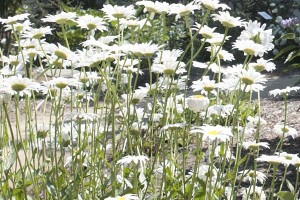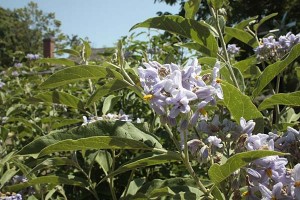History is a fragile thing, something that I was reminded of on my recent visit to Sonoma County.
Pioneering plantsman Luther Burbank moved to this area in the mid-1880s, making his home in Santa Rosa, and establishing a plant breeding and trial location nearby on Gold Ridge, in present-day Sebastapol. Over his career, which included over 40 years of work at this location, he developed and introduced hundreds of varieties of food crops and ornamental plants–including the still-popular Shasta daisy, and was pretty much the Thomas Edison of the plant world.
You can visit his main residence in Santa Rosa, but it was the Gold Ridge Experiment Farm where the work of coming up with the new varieties took place. Our host in Sebastapol basically said that there wasn’t much to see of the farm anymore. But I was curious to stand in the middle of horticultural and agricultural history, so John and Jenny and I took a short trip to the site.
A small brown sign in downtown Sebastapol points to the farm, .7 miles away, and a second small brown sign down the road points left towards the location. The first thing that you see when you turn left, instead of some pastoral trial farm scene overflowing with historical flowers, is the bigger sign announcing the Burbank Heights & Orchards, an anonymous cluster of gray clapboard-sided apartment houses. A bit of trailblazing over the winding lane through the apartments eventually leads to a little yellow cottage in a clearing, along with a matching out-building and a greenhouse that must be as small as the bathrooms in the surrounding apartments.
If it weren’t for the greenhouse it’d be hard to know that this was the destination. But this was it. What’s left of major botanical history. (You can see the apartments in the background.)
The cottage dates to 1906, when the San Francisco earthquake scrapped the original structure. There’s an adjacent little cottage garden, with some examples of Shasta daisies and other plants with ties to Burbank and this location.
The hybrid penstemons here are modern varieties, but there’s an interesting unknown tall nightshade with purple flowers that was found growing on the site in 1980. Aside from the Shasta daisies, the plants of major historical interest here aren’t the horticultural pretties as much as the trees and shrubs nearby: Walnuts, berries, plums, cherries, hawthorns, roses, among many.
Some of the plants aren’t Burbank hybrids at all, but are stock that was used in his vegetable husbandry. Burbank’s work was all about improving on nature, not appreciating nature as it exists, so what nature you see in the form of the original species–including the Catalina Cherries native to California–were collected here for their potential value to what could be made with them.
In an article, “Luther Burbank : A Victim of Hero Worship,” Walter L. Howard writes that “[t]he science of breeding grew and advanced rapidly during the first two decades of the new century, and though it may not be generally recognized, the movement is traceable to Burbank as a potent activator. Professor H. J. Webber, a pioneer plant-breeder and geneticist and a contemporary of Burbank, has declared that through the influence of Burbank the science of plant breeding was advanced by at least twenty years and for this accomplishment alone, he deserved a sizable monument to his memory.” (Quoted at the Gold Ridge website.)
Today, Luther Burbank isn’t completely forgotten. There’s the little remaining farmstead, and the Burbank home in Santa Rosa. Burbank’s Shasta daisy is the official flower of Sebastapol. And there’s even a stretch of Highway 12 between Santa Rosa and Sebastapol that’s designated the Luther Burbank Memorial Highway. But Sonoma County, a region that’s living large as one of the hotspots of California wine country, seems a little distracted by other things than to pay large amounts of attention to a figure whose career saw the rise but not the fall of Prohibition in the United States.
So, should you plan a trip to God Ridge Experiment Farm? As a destination unto itself, probably not, unless you live nearby. But if you’re here for a visit to the Sonoma and Napa Valley wineries, sure, take the little side trip. It might be a little sad, but you’ll be glad you went.





So neat and interesting to visit a place like this and think of the gardener who worked the land. Those shastas are one of my favorites (though they are MOST floppy here in the south) so I appreciate the history.
That IS sad that this is all that’s left of LB’s workplace. I was in Santa Rosa once and was amazed there was so little about him, it was all about the Mission history (sad legacy to me) but nothing about horticulture. Which seems weird in a highly agricultural area. I didn’t know about Gold Ridge farm at the time and thought the house was it; I was even more disappointed.
Still, I was very interested in your description of the place and what’s still growing in it, and it is a bit like stepping into a desanctified cathedral: you can imagine what happened in the very place you’re standing on.
Very interesting reading – your picture of the little cottage reminds me of placed in England – Paignton where my older daughter lives has lots of medieval remnants and one is the old gaol which is a stone leanto in the middle of a development just as in your photo. Another was a small stone church – of St Pancras I think – in Exeter, plonk in the middle of a shopping mall courtyard. Talk about incongruities.
This story is very similar to the one about the legacy of one of our 19th century English horticultural ancestors: Ellen Wilmot. Her garden is totally lost, apart from a few dafs that linger. She was a leading light too and very influential in many ways, but thousands of her plants were taken away soon after her death and her house demolished.
I think it would be sad to go and visit there.
BTW, wouldn’t you hate to have a Highway named after you? To me that seems the ultimate insult in this particular case. A bridge, yes. But a stretch of road? Peculiar accolade.